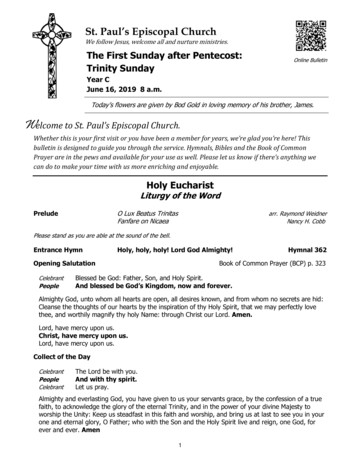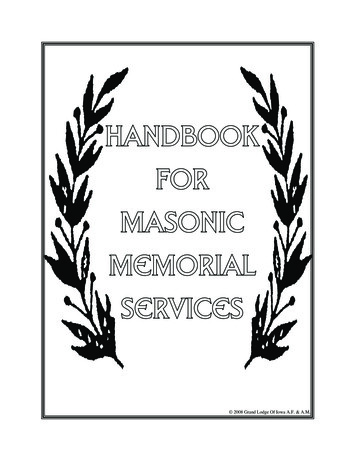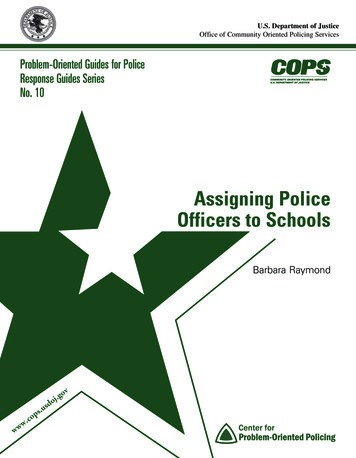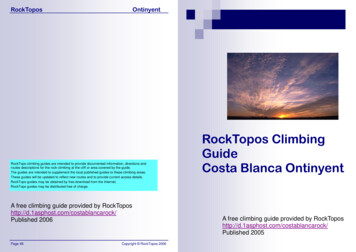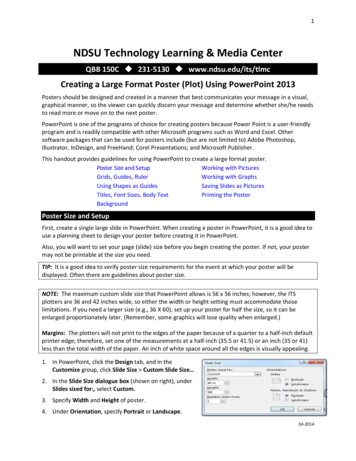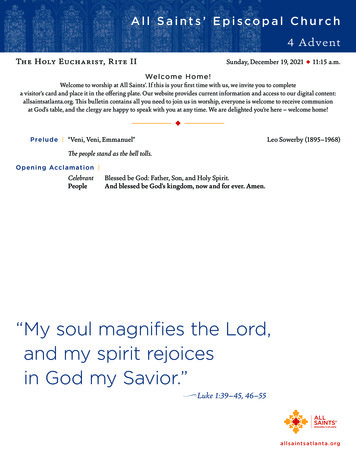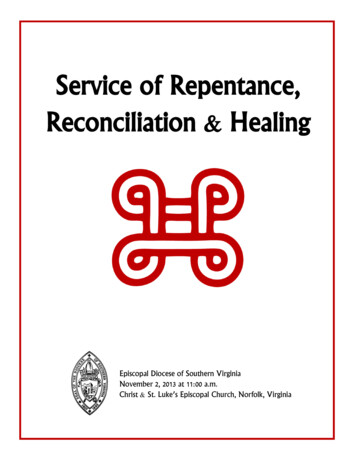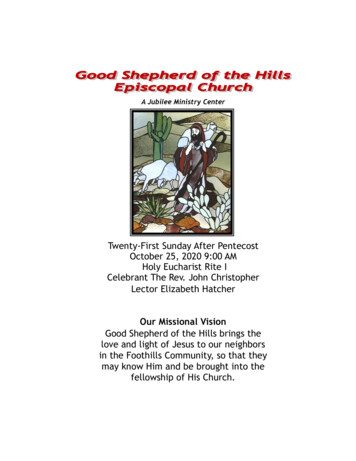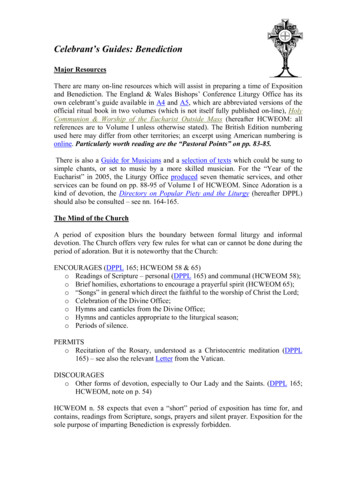
Transcription
Celebrant’s Guides: BenedictionMajor ResourcesThere are many on-line resources which will assist in preparing a time of Expositionand Benediction. The England & Wales Bishops’ Conference Liturgy Office has itsown celebrant’s guide available in A4 and A5, which are abbreviated versions of theofficial ritual book in two volumes (which is not itself fully published on-line), HolyCommunion & Worship of the Eucharist Outside Mass (hereafter HCWEOM: allreferences are to Volume I unless otherwise stated). The British Edition numberingused here may differ from other territories; an excerpt using American numbering isonline. Particularly worth reading are the “Pastoral Points” on pp. 83-85.There is also a Guide for Musicians and a selection of texts which could be sung tosimple chants, or set to music by a more skilled musician. For the “Year of theEucharist” in 2005, the Liturgy Office produced seven thematic services, and otherservices can be found on pp. 88-95 of Volume I of HCWEOM. Since Adoration is akind of devotion, the Directory on Popular Piety and the Liturgy (hereafter DPPL)should also be consulted – see nn. 164-165.The Mind of the ChurchA period of exposition blurs the boundary between formal liturgy and informaldevotion. The Church offers very few rules for what can or cannot be done during theperiod of adoration. But it is noteworthy that the Church:ENCOURAGES (DPPL 165; HCWEOM 58 & 65)o Readings of Scripture – personal (DPPL 165) and communal (HCWEOM 58);o Brief homilies, exhortations to encourage a prayerful spirit (HCWEOM 65);o “Songs” in general which direct the faithful to the worship of Christ the Lord;o Celebration of the Divine Office;o Hymns and canticles from the Divine Office;o Hymns and canticles appropriate to the liturgical season;o Periods of silence.PERMITSo Recitation of the Rosary, understood as a Christocentric meditation (DPPL165) – see also the relevant Letter from the Vatican.DISCOURAGESo Other forms of devotion, especially to Our Lady and the Saints. (DPPL 165;HCWEOM, note on p. 54)HCWEOM n. 58 expects that even a “short” period of exposition has time for, andcontains, readings from Scripture, songs, prayers and silent prayer. Exposition for thesole purpose of imparting Benediction is expressly forbidden.
In the past, it was customary to give special reverence to the Blessed Sacrament whenexposed by genuflecting on both knees (a “double genuflection”). The Church nowasks for a single genuflection (one knee only: HCWEOM n. 53), to emphasise thatChrist is present in the same way whether exposed or reposed.It is normative (HCWEOM n. 54) that when the Blessed Sacrament is exposed in amonstrance, incense should be used and 4 or 6 candles be lit. The norm presupposesthat the same number of candles, at least 4, are customary for Mass – the mind of theChurch is clearly that for simple Exposition, the number of candles should be thesame as for a simple Mass. In England & Wales, it is common practice that only twoaltar candles are used for Mass, and the omission of the rubric requiring at least 4candles for a monstrance in the recent Guide should be taken as implying that in suchcases, only 2 candles should be used for exposition – though strictly the law seems torequire the restoration of at least 4 candles for Mass.In the new GIRM, n. 277 specifies that the Blessed Sacrament is to be honoured by“three swings of the thurible”. Double swings are not specified, nor is it everprescribed that the chains should clink when swung. Three distinct, and silent, singleswings of the thurible suffice to fulfil the current rite, though three double swingswould also be permissible, and in keeping with past practice. The symbolism is visualand olfactory, not audible; incense should visibly rise from the thurible. There are norubrics concerning the use of a bell in the current rite of Benediction. Nor do thecurrent rubrics specify the old practice (still presumed) that the incense is not to beblessed when in the presence of the exposed Sacrament.For exposing or simply reposing the Blessed Sacrament, a cleric should wear a stoleover an alb or over a cassock and surplice (HCWEOM n. 57). The minister spends abrief time in adoration and says a prayer with the faithful present. For givingBenediction, a cleric uses a white cope and humeral veil (HCWEOM n. 61). Anextraordinary minister of holy communion may expose and repose the sacrament, butnot give a blessing (HCWEOM n. 60); unless there are diocesan policies, such aminister may wear an alb or appropriate normal clothing.There are slightly different rubrics in HCWEOM for “exposition in the ciborium”. Ihave not related those here because this custom is rarely used except on MaundyThursday.There are also norms for Eucharistic processions.Above all, remember that the Church expects reverent silence to be a significant partof Eucharistic Adoration; and the security of the Blessed Sacrament is paramount.Additional insight for the rite of Benediction may be gained from Chapter 11 of PeterElliott’s Ceremonies of the Modern Roman Rite (Volume I) – which does not simplygive the liturgical law of the Church, but also fills in details which are not specified inofficial documents, in the light of past tradition and customary practice.
THE NORMATIVE PATTERN FOR BENEDICTION IN THE MONSTRANCEPreparationIncense is prepared – the lit thurible near the altar of adoration if there is no thurifer.The altar is prepared with a corporal (and throne), and a suitable number of candles.The cleric vests in alb or cassock & surplice, with a white stole.The sanctuary and body of the church are suitably illuminated.Any booklets, hymnals, etc., needed for Benediction are distributed beforehand.If there is a long distance to carry the Blessed Sacrament from its tabernacle to thealtar, the minister should use a humeral veil and be accompanied by candles.OpeningA song may be sung while the minister comes to the altar.The minister exposes the Blessed Sacrament on the altar.After a moment of personal adoration, the minister sings or says a prayer.The minister incenses the Blessed Sacrament with three swings.He may then withdraw, or remain throughout adoration.DuringAccording to what HCWEOM says “should” take place, the content should include:o Readings from Scriptureo Brief homilies and exhortationso Songso Prayerso Periods of silence.BenedictionThe minister approaches the altar, genuflects, and kneels.While the congregation sings a Eucharistic Song, the minister, kneeling, incenses theBlessed Sacrament.After the song, the minister stands, and says “Let us pray.”After a pause, he prays one of the seven collects given at HCWEOM 68; it ispresumed that his hands are in the orans position.The minister puts on the humeral veil, genuflects, and takes the monstrance. Hemakes the sign of the Cross over the people in silence.ConclusionThe minister who gave Benediction, or another cleric, replaces the Blessed Sacramentin the tabernacle. Meanwhile, the people may (but needn’t) sing or say anacclamation. There is no ritual reason to place the monstrance back on the altar, butthe practicalities of removing the Blessed Sacrament from the monstrance mayrequire this.After replacing the Sacrament in the tabernacle, the reposing minister genuflects.After reposition, it is commendable for the celebrant to lead the congregation to animage of the Blessed Virgin for a hymn or antiphon in her honour, followed by atraditional prayer.At the end of the service, the minister leaves without further ceremony.
Traditional FormsThe following elements are traditionally included, but none of them are specified inthe current rite:(a) Tantum ErgoTantum ergo SacraméntumVenerémur cérnui:Et antiquum documéntumNovo cedat ritui:Praestet fides suppleméntumSénsuum deféctui.Genitori, Genitoque,Laus et jubilatio.Salus. honor. virtus quoqueSit et benedictio;Procedénti ab utroque;Compar sit laudátio.The Tantum Ergo, part of the Mass of the Lord’s Supper and often used as theEucharistic Hymn immediately before Benediction, is actually the last two verses ofSt Thomas Aquinas’ hymn Pange Lingua. In current liturgical use it is usually sung toone of two tunes: the plainchant tone of the Pange Lingua or the tune St Thomas fromS. Webbe’s 1792 Mottetts or Antiphons. Confusingly, there is also a lesser-used tunecalled Tantum Ergo, also by Webbe. It could also be sung to other 87.87.87 tunes,notably Picardy (known for the words Let All Mortal Flesh Keep Silence). Thesetunes are also valuable for the Office Hymns at Morning Prayer and the Office ofReadings on Good Friday.The full text of the Pange Lingua can be found in English and Latin in many hymnbooks: see under “Sing, my tongue, the Savior's glory” or “Of the glorious bodytelling” for common translations, also “Come adore this wondrous presence” for justthe Tantum Ergo verses. The full text is also available in Welsh, to the same metre, n.32 in the 2006 Emynau Catholig, ISBN 0-9552697-0-9.(b) Short ResponsoryThe following versicle and response is often used as a bridge between the TantumErgo and the Collect. In practice, few people seem to know the English form, and itexists in popular memory in subtly different translations. Panem de caelo praestitisti eis. Omne delectamentum in se habentem. You have given your people bread from heaven. The bread which is full of all goodness.
(c) The Divine PraisesThe following acclamations may be spoken by the celebrant and whole congregationtogether, or said first by the celebrant and echoed by the people. Common practice isthat they are said after Benediction and before the repose of the Blessed Sacrament,even though the version of HCWEOM for England & Wales does not specificallyallow for prayers to be said at this point. For a discussion of the proper place of theDivine Praises, see McNamara.Blessed be God.Blessed be His Holy Name.Blessed be Jesus Christ, true God and true Man.Blessed be the Name of Jesus.Blessed be His Most Sacred Heart.Blessed be His Most Precious Blood.Blessed be Jesus in the Most Holy Sacrament of the Altar.Blessed be the Holy Spirit, the Paraclete.Blessed be the great Mother of God, Mary most Holy.Blessed be her Holy and Immaculate Conception.Blessed be her Glorious Assumption.Blessed be the Name of Mary, Virgin and Mother.Blessed be St. Joseph, her most chaste spouse.Blessed be God in His Angels and in His Saints.(d) O SalutarisThis common Latin hymn was traditionally used at the time of opening the tabernacleor placing the Blessed Sacrament on the altar. It is often used with the tune Melcombethough other Long Metre tunes are possible. For English versions, see hymnals under“O Saving Victim”.O salutáris hôstiaQuae caeli pandis óstiumBella premunt hostiliaDa robur, fer auxilum.Uni Trinóque DominoSit sempitérna gloriaQui vitam sine términoNobis donet in pátria.(e) Adoremus in AeternumAnother common Latin hymn. The people may sing the whole text, or complement acantor with the initial and final stanzas and the response to the Gloria Patri.Adorémus in aetérnumsantissimum Sacraméntum.Laudâte Dóminum, omnes gentes;Laudáte eum omnes pópuli.Quóniam confirmátaest super nos misericórdia ejus;et véritas Dómini manet in aetérnum.Glória Patri et Filio, et Spiritui Sancto.Sicut erat in principio, et nunc, et semper, et in saécula saeculórum. Amen.Adorémus in aetérnumsantissimum Sacraméntum.
THE TRADITIONAL PATTERN FOR BENEDICTION IN THE MONSTRANCEPreparation, opening and prayers during Exposition proceed as above, using OSalutaris as the opening song.O salutáris hôstiaQuae caeli pandis óstiumBella premunt hostiliaDa robur, fer auxilumUni Trinóque DominoSit sempitérna gloriaQui vitam sine términoNobis donet in pátria.BenedictionThe minister approaches the altar, genuflects, and kneels.While the congregation sings the Tantum Ergo, the minister, kneeling, incenses theBlessed Sacrament with three double swings.Tantum ergo SacraméntumVenerémur cérnui:Et antiquum documéntumNovo cedat ritui:Praestet fides suppleméntumSénsuum deféctui.Genitori, Genitoque,Laus et jubilatio.Salus. honor. virtus quoqueSit et benedictio;Procedénti ab utroque;Compar sit laudátio.After the song, the minister stands, and leads the responsory: Panem de caelo praestitisti eis. Omne delectamentum in se habentem.OR You have given your people bread from heaven. The bread which is full of all goodness.He then says “Let us pray:” / “Oremus:”After a pause, he prays the following collect with hand in the orans position:Deus qui nobis sub Sacramento mirabilis passionis tuae memoriam reliquisti,tribue quaesumus, ita nos corporis et sanguinis tui sacra mysteria venerari;Ut redemptionis tuae fructum in nobis iugiter sentiamus.Qui vivis et regnas in saecula saeculorum. Amen.
ORO God, who in this wonderful sacrament has left us a memorial of your passion,Help us so to reverence the sacred mysteries of your body and bloodthat we may always experience in our lives the effects of your redemption.Who live and reign for ever and ever. Amen.The minister puts on the humeral veil, genuflects, and takes the monstrance. Hemakes the sign of the Cross over the people in silence. He then returns the monstranceto the altar and leads the people in the Divine Praises.Blessed be God.Blessed be His Holy Name.Blessed be Jesus Christ, true God and true Man.Blessed be the Name of Jesus.Blessed be His Most Sacred Heart.Blessed be His Most Precious Blood.Blessed be Jesus in the Most Holy Sacrament of the Altar.Blessed be the Holy Spirit, the Paraclete.Blessed be the great Mother of God, Mary most Holy.Blessed be her Holy and Immaculate Conception.Blessed be her Glorious Assumption.Blessed be the Name of Mary, Virgin and Mother.Blessed be St. Joseph, her most chaste spouse.Blessed be God in His Angels and in His Saints.The minister who gave Benediction, or another cleric, now replaces the BlessedSacrament in the tabernacle. Meanwhile, the people may (but needn’t) sing or say anacclamation, perhaps Adoremus in Aeternum.Adorémus in aetérnumsantissimum Sacraméntum.Laudâte Dóminum, omnes gentes;Laudáte eum omnes pópuli.Quóniam confirmátaest super nos misericórdia ejus;et véritas Dómini manet in aetérnum.Glória Patri et Filio, et Spiritui Sancto.Sicut erat in principio, et nunc, et semper, et in saécula saeculórum. Amen.Adorémus in aetérnumsantissimum Sacraméntum.After replacing the Sacrament in the tabernacle, the reposing minister genuflects.After reposition, it is commendable for the celebrant to lead the congregation to animage of the Blessed Virgin for a hymn or antiphon in her honour, followed by atraditional prayer. At the end of the service, the minister leaves without furtherceremony.
Additional ResourcesVolume I of HCWEOM contains a wealth of useful material in appendices.Particularly worth reading are the “Pastoral Points” on pp. 83-85. Other material canbe found online.Useful Advicep. 82 Catechetical Pointsp. 83 Pastoral Points – highly recommendedIt is possible to introduce even young children to Adoration; some useful resources toassist with this may are produced by Children of Hope. In the UK, useful resourceshave been produced by Jean Merriman in Northampton.Jean Merriman - presenting Workshop: ‘Let the children come to me’From the 2006 Celebrate ConferenceMother to 5 grown-up children, Jean became a Catholic at 17. Her Faith was ‘head stuff’ for years. Thebreakthrough to ‘her heart’ happened one weekend at her Sacred Heart Parish, Northampton, when FrJohn Edwards ran a mission to establish ongoing Eucharistic Adoration. During one session Jeanbecame suddenly aware of the presence of Jesus in the Blessed Sacrament and fell totally in love withHim in that form!7 years later she experienced Charismatic Renewal, finding the reality of the Lord outside the context, ofthe Eucharist. The Lord has since led her to draw children to Him in the Eucharist. A teacher and REand liturgy coordinator for St. Mary’s Catholic Primary School in Northampton, Jean passionatelycommitted to passing on her Faith, leading children into a living relationship with Jesus and facilitatingits growth. The challenge is that so many pupils have no religious background and few come frompractising Catholic families. With the support of her Head, Jean has modelled, taught and led the schoolin a variety of ways of praying, believing each effects a response in different children.An exciting development came from leading a short period of Exposition after a Corpus Christi Mass. Itwas so well received - with children so attentive - a service with short exposition session now takesplace each half term. ‘By far the most important thing we have done. The response is amazing andimmediate.’Her ‘Let the children come to Me’ workshop encourages adults to do this in their own communities. Jeansays: ”I am sure there is real hunger in children to be led to the Lord, to spend quality timein his presence, sing to Him, hear His word, be led by guided meditation and just left in silence to enjoyHis Presence and His company. I tell them – ‘just enjoy being with Him’ - and they do !”
Content for Exposition Periodp. 62 Responsoriesp. 66 Patterns of Expositionp. 88 Sample Services for different liturgical seasonsSee also the suggestions for the “Year of the Eucharist” in 2005.p. 80 Meditation Prayersp. 71 Thematic ScripturesVolume II contains many more Scripture readings.The six officially-approved litanies of the Church can be found at the bottom ofthis page.p. 78 Litanies & AcclamationsTraditional Croatian Sung LitanyHail Body of Jesus, consecrated on the altarHail Body of Jesus, conceived by the Holy SpiritHail Body of Jesus, bom of the VirginHail Body of Jesus, placed in a mangerHail Body of Jesus, so greatly torturedHail Body of Jesus, nailed to the cross for usHail Body of Jesus, buried in a tombHail Body of Jesus, risen on the third dayHail Body of Jesus, ascended to HeavenHail Body of Jesus, glorified throughout the worldHail Body of Jesus, given to all for our foodHail Bread, sweeter than honey, food of faithful soulsHail Trinity in unity, hail Jesus in divinityYours be the thanks, the praise, the glory most great.Jesus, be praised for ever and ever.
Musicp. 59 & 75 Hymnsp. 61 Antiphonsp. 86 Background musicGuide for MusiciansSelection of textsSimple chants can be very effective – a short phrase, easily memorised, meansthat worshippers don’t have to keep looking at hymn books or service sheets whenthey could be gazing on the Eucharistic Presence of Jesus. While ““O SacramentMost Holy” is well-known, there are many other suitable chants.Settings of the Eucharistic Acclamations “Lord by Your Cross and Resurrection”(especially on Fridays and in Lent) and “Dying You Destroyed Our Death” couldbe used appropriately.In Christmastide, the “O Come Let Us Adore Him” refrain to O Come All yeFaithful (Adeste Fidelis) is very suitable.“He is Lord, He is Lord, He is risen from the dead ” would be very appropriateon Sundays and in Eastertide.Many Taizé chants will also be appropriate:Jesus Remember MeLaudate DominumLaudate Omnes GentesO Christe Domine JesuUbi Caritas
Benediction, a cleric uses a white cope and humeral veil (HCWEOM n. 61). An extraordinary minister of holy communion may expose and repose the sacrament, but not give a blessing (HCWEOM n. 60); unless there are diocesan policies, such a minister may wear an alb or appropriate normal clothing.
![Prayer of the Faithful 2022 [eBook]](/img/18/30146865.jpg)
